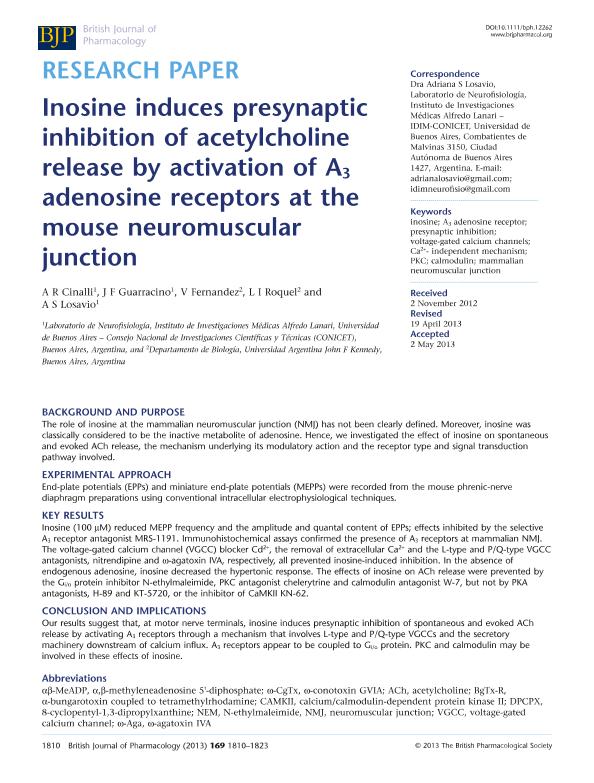Artículo
Inosine induces presynaptic inhibition of acetylcholine release by activation of A3 adenosine receptors at the mouse neuromuscular junction
Cinalli, Alejandro Raúl ; Guarracino, Juan Francisco; Fernández, Verónica Guillermina; Roquel, L. I.; Losavio, Adriana Silvia
; Guarracino, Juan Francisco; Fernández, Verónica Guillermina; Roquel, L. I.; Losavio, Adriana Silvia
 ; Guarracino, Juan Francisco; Fernández, Verónica Guillermina; Roquel, L. I.; Losavio, Adriana Silvia
; Guarracino, Juan Francisco; Fernández, Verónica Guillermina; Roquel, L. I.; Losavio, Adriana Silvia
Fecha de publicación:
08/2013
Editorial:
Wiley
Revista:
British Journal of Pharmacology
ISSN:
0007-1188
e-ISSN:
1476-5381
Idioma:
Inglés
Tipo de recurso:
Artículo publicado
Clasificación temática:
Resumen
BACKGROUND AND PURPOSE: The role of inosine at the mammalian neuromuscular junction (NMJ) has not been clearly defined. Moreover, inosine was classically considered to be the inactive metabolite of adenosine. Hence, we investigated the effect of inosine on spontaneous and evoked ACh release, the mechanism underlying its modulatory action and the receptor type and signal transduction pathway involved. EXPERIMENTAL APPROACH: End-plate potentials (EPPs) and miniature end-plate potentials (MEPPs) were recorded from the mouse phrenic-nerve diaphragm preparations using conventional intracellular electrophysiological techniques. KEY RESULTS: Inosine (100 μM) reduced MEPP frequency and the amplitude and quantal content of EPPs; effects inhibited by the selective A3 receptor antagonist MRS-1191. Immunohistochemical assays confirmed the presence of A3 receptors at mammalian NMJ. The voltage-gated calcium channel (VGCC) blocker Cd(2+) , the removal of extracellular Ca(2+) and the L-type and P/Q-type VGCC antagonists, nitrendipine and ω-agatoxin IVA, respectively, all prevented inosine-induced inhibition. In the absence of endogenous adenosine, inosine decreased the hypertonic response. The effects of inosine on ACh release were prevented by the Gi/o protein inhibitor N-ethylmaleimide, PKC antagonist chelerytrine and calmodulin antagonist W-7, but not by PKA antagonists, H-89 and KT-5720, or the inhibitor of CaMKII KN-62. CONCLUSION AND IMPLICATIONS: Our results suggest that, at motor nerve terminals, inosine induces presynaptic inhibition of spontaneous and evoked ACh release by activating A3 receptors through a mechanism that involves L-type and P/Q-type VGCCs and the secretory machinery downstream of calcium influx. A3 receptors appear to be coupled to Gi/o protein. PKC and calmodulin may be involved in these effects of inosine.
Archivos asociados
Licencia
Identificadores
Colecciones
Articulos(IDIM)
Articulos de INST.DE INVEST.MEDICAS
Articulos de INST.DE INVEST.MEDICAS
Citación
Cinalli, Alejandro Raúl; Guarracino, Juan Francisco; Fernández, Verónica Guillermina; Roquel, L. I.; Losavio, Adriana Silvia; Inosine induces presynaptic inhibition of acetylcholine release by activation of A3 adenosine receptors at the mouse neuromuscular junction; Wiley; British Journal of Pharmacology; 169; 8; 8-2013; 1810-1823
Compartir
Altmétricas



